Committed to heritage and low impact hospitality services, Amarela Resort is a charming eco-resort perched on the Panglao Island coastline of the Philippines. An old Visayas art form - Boholano - is revived in a number of ways here, and the environment is given tender loving care as well, reviews Gaia Discovery. Text and photos by Mallika Naguran.
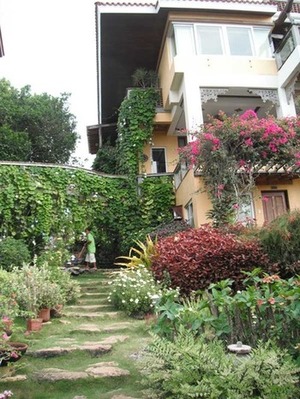
Amarela Resort's yellow walls are matched brightly by green foliage
Singapore, 1 September 2011. Amarela Resort - a home away from home for weary travellers – is a sunshiny lodge development sitting on the Barangay Libaong coastline of Panglao Island. The mustard yellow paint (Amarela means ‘yellow’ in Portuguese) on the exterior evokes bright prospects and comfort waiting behind the high walls and heavy wooden doors. Walk right in, and comfort embraces you.
But Amarela isn’t just a cool looking resort. Far from it, this cozy understated lodge is also a walk-in gallery to bask in the art of a particular Filipino form – Boholano. It doesn’t stop there. Amarela is also an eco-resort – but nowhere on the website suggests this. Such is the understated charm of the place, and modesty of the proprietors, Lucas M Nunag and his wife Ludichi Yasay.
The former lawyers (retired) have been partners in life for a long time and since 2006 in the business of hospitality services and eco-tourism, starting with environmentally friendly practices on their own property, and extending outwards towards the rest of Panglao Island, part of Bohol province.
“The vision of Bohol is to be a prime eco-tourism destination. It is a lofty vision but then that’s how visions are,” laughed Lucas M Nunag, who is also the Chairman of the Provincial Tourism Council of Bohol. Apart from loving nature and wildlife, Nunag is also passionate about the arts, having grown up in Antequera that is known as the handicraft centre of Bohol and famed for its traditional basketry.
Bohol Heritage Preserved

Lucas Nunag collects Boholano art to preserve its age-old heritage
Amarela resort is a work of art itself. What initially was planned as a seven-room retirement home for the Nunags became an extended lodge of 20 guestrooms, as more and more friends started dropping in, finding delight in the idyllic getaway.
Wood is celebrated at Amarela. “Bohol has a lot of religious influence, which accounts for the wooden structure. We look into revival of former and traditional art forms using old wood,” says Nunag.
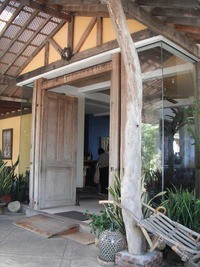
Doors, windows, floor boards retrieved from old houses come to live at Amarela Resort
Old wood is retrieved from dilapidated structures and even from the kilns, otherwise such a past treasure will be burnt. At Amarela, this valuable resource is sawed and crafted for a number of the fittings for the lobby area, the dining facility, the reading room, the gallery, why even the window frames and toilet doors evidenced by intricate latticework.
The flooring is made from the molave wood of abandoned old houses, giving it a rustic but solid feel. The tall front doors of the resort once belonged to a garrison, so that a block of heritage is preserved for present and future generations to appreciate.
There are old rocking chairs at the waiting area, altars and altar tables that act as display pieces, a trunk bench to sit on in the middle courtyard that has a raised ceiling to channel sea breeze through the open spaces. Carved ventilators made out of calado wood are as functional as they are aesthetic, providing ventilation to keep the premises cool during hot climes that can reach as high as 30 degrees Celsius or more during the dry season.
At the art gallery on the third level, guests can amble by paintings and crafts produced by locals, not necessarily pros. “We are hoping to have enough artisans to revive Boholano art,” says Nunag. He related how he had commissioned an 81-year-old “nenek” (or grandmother in Bahasa Melayu) named HB Lungay to paint village scenes, which she did. “This is just one of the ways we preserve our heritage,” he beams as we both take time to admire her work of art.
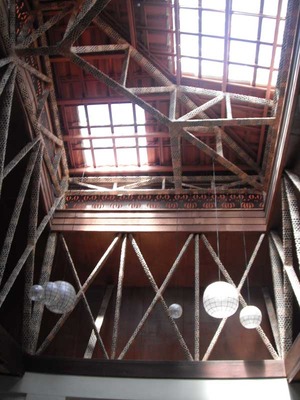
At Amarela Resort on Panglao Island, Bohol, sunrays filter through glass covered gaps in the ceiling of the courtyard
Supporting community art, Nunag had also helped restore an old village chapel by getting local artists to paint it. Perhaps art cultivation is part of an overall need to preserve the beauty of the environment in which he lives.
Sustainable Resort for a Greener Bohol
Showers can take a while to heat up, but do be patient as the solar panel systems installed on the rooftops help keep the air carbon free. Amarela Resort is striving towards low energy use, minimal pollution, and maximum reuse and recycling of resources to ensure that it remains a low impact business.
Food waste from the restaurant is collected and given to farmers in return for a roast pig for staff's Christmas party. Ceramic soap dispensers crafted by artisans replace disposable shampoo sachets and soap bottles.
Wastewater is treated using the reed filtration method. “Amarela was one of the few resorts that took up a USAID assistance scheme for waste water treatment,” says Nunag, adding that the cleaned effluent is leached out to the ornamental plants in the garden. The contaminants and surfactants from the septic tanks are efficiently absorbed by the root system of the reeds which are endemic to Bohol.
Compact fluorescent lamps provide energy saving luminence, but aware that CFLs contain mercury, Nunag is looking to switch to light emitting diodes (LED) lamps instead. Passive design using open spaces and light reflectors are also in place to reduce energy consumption even further.
During construction of the resort, I am told, lots of care was given to keeping indigenous trees in place. “We have a lot of birds here, in particular, the orange-crested sunbird frequents here,” smiles Nunag. There are a lot of greens too, to soothe the eye and calm the nerves. Potted flowering plants, creepers and climbers do their part by surrounding walls and overhead shelters. Trellises are combed through with thunbergia vines, keeping the glare of the sun out, but not the birds and bees.
Bohol Marine Conservation
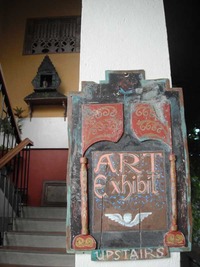
Gallery at Amarela Resort features paintings, sculpture & furniture
When Nunag isn’t busy at council meetings discussing sustainable projects for Panglao Island and Bohol, he zips up his wetsuit and enters the warm clear waters to enjoy the beauty of the underwater world.
It is natural for this avid scuba diver to advocate marine conservation, knowing that much harm has been done to ocean wildlife, especially he says at Pamilacan Island where whales had been hunted, and Cabilao Island where hammerhead sharks were fished out. “This happened a decade ago, and the fishing eradicated the hammerhead shark population – it’s really sad,” he laments.
Not withstanding the loss, and eager to replenish lost marine creatures, Nunag helped set up a marine sanctuary near the resort four years ago. With the collaboration of the villagers and consent of the government, five hectares of marine area have been identified for conservation, which means no fishing is permitted within this demarcated zone.
“There are laws that disallow fishing within a 15km from the beach, but unfortunately there are not enough patrol boats to monitor the area,” he adds. Marine tourism in the Philippines is an important contributor to a growing economy, as such having healthy and diverse corals, fishes, mollusks, turtles, rays, whales and more are needed to appeal to snorkellers and scuba divers. We discuss the need for greater political will and community education.
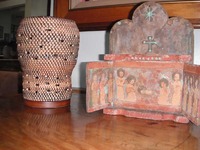
Bohol, famed for its traditional basket weaving and religious influences
At the start, Nunag chose to build Amarela Resort on the beach close to popular Panglao dive sites for his personal and family interest, as his children are also keen scuba divers. Now, Amarela Resort serves the interest of the community too, as a house of Boholano art. One can drop in for a steaming cup of latte and browse through the collection of design and architecture coffeetable books, sitting at the grand wooden boardroom table, facing out to the blue Bohol Sea.
“We are still sustaining the provincial flavour and heritage, because no one else is doing it,” says Nunag.
Visit Amarela Resort at http://www.amarelaresort.com.
How to get to Amarela Resort:
For overseas travellers, take a flight to Manila City and then a slow ferry (25 hours) or fast flight to Cebu island (45 mins) where you can relish the sights and sounds there. From Cebu, take a fast boat (an hour and half) such as SuperCat (instead of four-hour slow boat) to connect to Bohol, alighting at Tagbilaran seaport. Alternatively take a 1 hr 10 mins flight from Manila City direct to Tagbilaran Airport of Bohol. Cebu Pacific has an extensive domestic as well as international flight routes, so check them out. Once in Bohol, a cab can take you to Panglao Island via a highway bridge.
Where to explore and eat? Chocolate Hills at Bohol for marvellous sight-seeing, Bee Farm at Bohol for delicious homegrown spread, Amorita Resort for romantic beachside dining at Panglao and Dumaloan Beach Resort for marine sports.
You can also avoid the hassle of planning a trip on your own by consulting and booking up with locally-based tour agencies such as Angels Wings Tours & Travel.
Useful Links:
Asia Society for Social Improvement and Sustainable Transformation
Philippine Green Building Council
PATH Foundation Philippines
